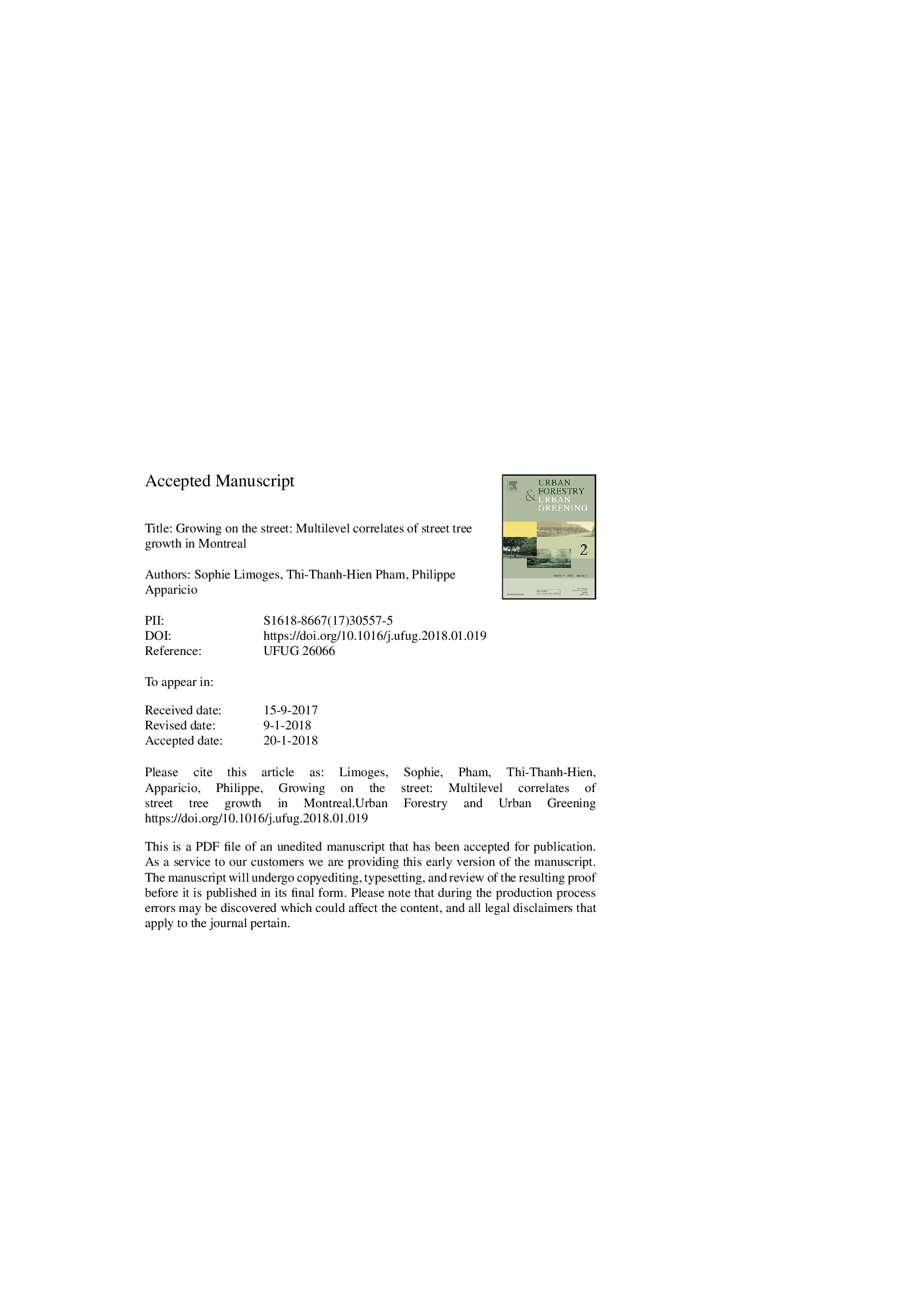| کد مقاله | کد نشریه | سال انتشار | مقاله انگلیسی | نسخه تمام متن |
|---|---|---|---|---|
| 6549217 | 1421859 | 2018 | 28 صفحه PDF | دانلود رایگان |
عنوان انگلیسی مقاله ISI
Growing on the street: Multilevel correlates of street tree growth in Montreal
ترجمه فارسی عنوان
رشد در خیابان: همبستگی چندسطحی در رشد درخت در مونترال
دانلود مقاله + سفارش ترجمه
دانلود مقاله ISI انگلیسی
رایگان برای ایرانیان
کلمات کلیدی
درختان خیابانی، رشد درخت، شرایط کاشت، فرم شهری، مدلهای چندسطحی،
ترجمه چکیده
کاشت درختان در بسیاری از شهرهای آمریکای شمالی، از جمله مونترال، مورد هدف قرار گرفته است که هدف آن افزایش تاج پوشش آن از 20 تا 25 درصد در سال 2025 است. با این حال، میزان مرگ و میر درختان خیابانی در چند سال اول پس از کاشت به ویژه بالا است. مطالعات نشان داده است که متغیرهایی که درخت درگیر هستند و مربوط به مکان آن، شکل شهری و ویژگی های اجتماعی و دموگرافیک محیط اطراف به میزان قابل توجهی با میزان بقاء درختان و پوشش پوشش گیاهی ارتباط دارد. در این تحقیق، متغیرهایی وجود دارند که ارتباطات آماری با رشد درخت دارند که قطر آن در طول سینه تقسیم بر تعداد سالها بر روی زمین برای حدود 28000 درخت درخت در مونترال است. متغیرهای مستقل به سه مقیاس فضایی درخت (گونه و متغیرهای فیزیکی)، بخش خیابانی (متغیرهای شکل شهری) و بخش سرشماری (متغیرهای اجتماعی و دموگرافیک) توزیع شدند. مدل های چندسطحی نشان می دهد که 51.55 درصد از واریانس رشد به طور بالقوه توسط گونه ها و کاشت شرایط فیزیکی مانند سمت شرقی و شمالی (ارتباط مثبت با رشد)، نشان می دهد به عنوان یک انسداد (ارتباط منفی). 28.54٪ از واریانس رشد به طور بالقوه با فرم شهری، در مورد سن ساختار ما (رابطه محدب با رشد)، منطقه بندی مخلوط (منفی) و منطقه بندی مسکونی (مثبت) توضیح داده شده است. در سطح محله، هر چند هیچ یک از متغیرهای ما قابل توجه نیست، 6.95٪ از واریانس رشد به طور بالقوه با سایر متغیرهای گمشده توضیح داده می شود. از این رو برنامه های جدید کاشت باید به منظور بهبود رشد درختان، شکل شهری را در نظر بگیرند.
موضوعات مرتبط
علوم زیستی و بیوفناوری
علوم کشاورزی و بیولوژیک
جنگلداری
چکیده انگلیسی
Tree planting has been favoured in many North American cities, including Montreal which aims to increase its canopy from 20% to 25% in 2025. However, the mortality rate of street trees is especially high in the first few years after planting. Studies have shown that variables that are intrinsic to the tree and those related to its location, the urban form and the socio-demographic characteristics of the surrounding environment are significantly associated either with trees' survival rate or with vegetation cover. In this research we examine variables that have statistical associations with tree growth, which is the diameter at breast height divided by the number of years on the ground, for approximately 28,000 street trees in Montreal. Independent variables were nested into three spatial scales: the tree (species and physical variables), the street section (urban form variables), and the census tract (socio-demographic variables). Multilevel models reveal that 65.51% of the growth variance is potentially explained by the species and planting physical conditions such as the east and north sides (positive associations with the growth), signage as an obstruction (negative association). 28.54% of the grow variance is potentially explained by the urban form, in our case building age (convex relationship with the growth), mixed zoning (negatively) and residential zoning (positively). At the neighbourhood level, although none of our variables is significant, 6.95% of the growth variance is be potentially explained by other missing variables. New planting programs should hence consider the urban form in order to improve tree growth.
ناشر
Database: Elsevier - ScienceDirect (ساینس دایرکت)
Journal: Urban Forestry & Urban Greening - Volume 31, April 2018, Pages 15-25
Journal: Urban Forestry & Urban Greening - Volume 31, April 2018, Pages 15-25
نویسندگان
Sophie Limoges, Thi-Thanh-Hien Pham, Philippe Apparicio,
